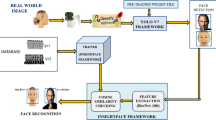Abstract
Face recognition is a problem that arises on many real world applications, such as those related with Ambient Intelligence (AmI). The specific nature and goals of AmI applications, however, requires minimizing the invasiveness of data collection methods, often resulting in a drastic reduction of data quality and a plague of unforeseen effects which can put standard face recognition systems out of action. In order to deal with this, a face recognition system for AmI applications must not only be carefully designed but also subject to an exhaustive configuration plan to ensure it offers the required accuracy, robustness and real-time performance. This document covers the design and tuning of a holistic face recognition system targeting an Ambient Intelligence scenario. It has to work under partially uncontrolled capturing conditions: frontal images with pose variation up to 40 degrees, changing illumination, variable image size and degraded quality. The proposed system is based on Support Vector Machine (SVM) classifiers and applies Gabor Filters intensively. A complete sensitivity analysis shows how the recognition accuracy can be boosted through careful configuration and proper parameter setting, although the most adequate setting depends on the requirements for the final system.
Similar content being viewed by others
References
Baker, S., Kanade, T.: Hallucinating Faces. Robotics Institute, Carnegie Mellon University. 1999. CMU-RI-TR-99-32 (1999)
Chesnokov, Y.: Face Detection C+Library with Skin and Motion Analysis. The Code Project: your development resource. [En línea] 2007. [Citado el: 13 de oct de 2008.] http://www.codeproject.com/KB/audio-video/face_detection.aspx (2007)
Chih-Chung, C., Chih-Jen, L.: LIBSVM: a library for support vector machines. [Online] 2001. http://www.csie.ntu.edu.tw/∼cjlin/libsvm (2001)
Chih-Wei, H., Chih-Chung, C., Chih-Jen, L.: A Practical Guide to Support Vector Classification. [Online] July 2007. [Cited: 8 April 2009.] http://www.csie.ntu.edu.tw/∼cjlin/papers/guide/guide.pdf (2007)
Daugman, J.G.: Uncertainty relation for resolution in space, spatial-frequency and orientation optimized by two dimensional visual cortical filters. J. Opt. Soc. Am. A. Opt. Image Sce. Vis. 2(7), (1985). doi:10.1364/JOSAA.2.001160
Hamamoto, Y., et al.: A Gabor filter-based for recognizing handwritten numerals. Pattern Recogn. 31(4), 395–400 (1998)
Heisele, B., Ho, P., Poggio, T.: Face recognition with Support Vector Machines: global vs. component-based approach. International Conference on Computer Vision. pp. 688–694 (2001)
Field, D.J.: Relations between the statistics of natural images and the response properties of cortical cells. J. Opt. Soc. Am. 4, 12 (1987)
Jain, A.K., Farrokhnia, F.: Unsupervised texture segmentation using Gabor filters. Pattern Recogn. 24(12), 1167–1186 (1991)
Jain, A.K., Ratha, N.K.: Object detection using Gabor filters. Pattern Recogn. 30, 295–309 (1997)
Jones, J., Palmer, L.: An evaluation of the two-dimensional Gabor filter model of simple receptive fields in cat striate cortex. J. Neurophysiol. 58(6), 1233–1258 (1987)
Kemal Ekenel, H., Fischer, M., Stiefelhagen, R.: Face recognition in smart rooms. Lecture Notes in Computer Science. s.l. : Springer Berlin/Heidelberg. 4892/2008, 120–131 (2008). doi:10.1007/978-3-540-78155-4_11
Lades, M., et al.: Distortion invariant object recognition in the Dynamic Link Architecture. IEEE Trans. Comput. 42(3), 300–311 (1993)
Levine, M.D., Yu, Y.: State-of-the-art of 3D facial reconstruction methods for face recognition based on a single 2D training image per person. Pattern Recogn. Lett. 30(10), 908–913 (2009). doi:10.1016/j.patrec.2009.03.011
Li, B., Chang, H., Shan, S., Chen, X., Gao, W.: Hallucinating facial images and features. In: 2008 19th International Conference on Pattern Recognition, pp. 1–4. IEEE (2008)
Liang, Y., et al.: Gabor features-based classification using SVM for face recognition. Advances in Neural Networks-ISNN 2005. vol. 2, pp. 118–123. 2nd China International Symposium on Neural Networks (2005)
Liu, C.J., Wechsler, H.: Gabor feature based classification using the enhanced Fisher Linear Discriminant model for face recognition. IEEE Trans. Image Process. 11(4), 467–476 (2002)
Mehrotra, R., Namuduri, K.R., Ranganathan, N.: Gabor filter-based edge detection. Pattern Recogn. 25, 12 (1992). doi:10.1016/0031-3203(92)90121-X
O’toole, A.J., et al.: Face Recognition Algorithms surpass Humans Matching Faces over Changes in Illumination. IEEE Trans. Pattern Anal. Mach. Intell. 29, 1642–1646 (2005)
Park, U., Jain, J.A.: 3D model-based face recognition in video. 2nd International Conference on Biometrics. Seoul : s.n. (2007)
Pentland, A., Choudhury, T.: Face recognition for smart environments. Computer. 33(2), 50–55 (2000). doi:10.1109/2.820039
Phillips, P.J.: Support vector machines applied to face recognition. Adv. Neural Inf. Process. Syst. 11, 803–809 (1999)
Shen, L., et al.: Gabor feature selection for face recognition using improved adaboost learning. Advances in Biometric PersonAuthentication. s.l.: Springer Berlin / Heidelberg 3781/2005, 39–49 (2005)
Vapnik, V.: The nature of statistical learning theory (1995)
Vuilleumier, P., et al.: Distinct spatial frequency sensitivities for processing faces and emotional expressions. Nat. Neurosci. 6, 624–631 (2003). doi:10.1038/nn1057
Wang, J., Asundi, A.K.: A computer vision system for wineglass defect inspection via Gabor-filter-based texture features. Inf. Sci. 127(3–4), 157–171 (2000). doi:10.1016/S0020-0255(00)00036-0
Wang, X., Xiaoou, T.: Face Hallucination and Recognition. (ed.) Springer Berlin/Heidelberg. Lecture Notes in Computer Science. ISBN 978-3-540-40302-9 (2003)
Weldon, T.P., Higgins, W.E., Dunn, D.F.: Efficion Gabor filter design for texture segmentation. Pattern Recogn. 29(12), 2005–2015 (1996)
Whittier, C., Xiaojun, Q.: Supervised heat kernel LPP method for face recognition. Computer Science Department-Utah State University. [Online]. http://www.cs.usu.edu/∼xqi/Teaching/REU06/Website/Crystal/CrystalFinalPaper.pdf (2006)
Wiskott, L., et al.: Face recognition by elastic bunch graph matching. IEEE Trans. PAMI 19(7), 775–779 (1997)
Author information
Authors and Affiliations
Corresponding author
Rights and permissions
About this article
Cite this article
Martí, E.D., Patricio, M.A. & Molina, J.M. A Practical Case Study: Face Recognition on Low Quality Images Using Gabor Wavelet and Support Vector Machines. J Intell Robot Syst 64, 447–463 (2011). https://doi.org/10.1007/s10846-011-9548-6
Received:
Accepted:
Published:
Issue Date:
DOI: https://doi.org/10.1007/s10846-011-9548-6




